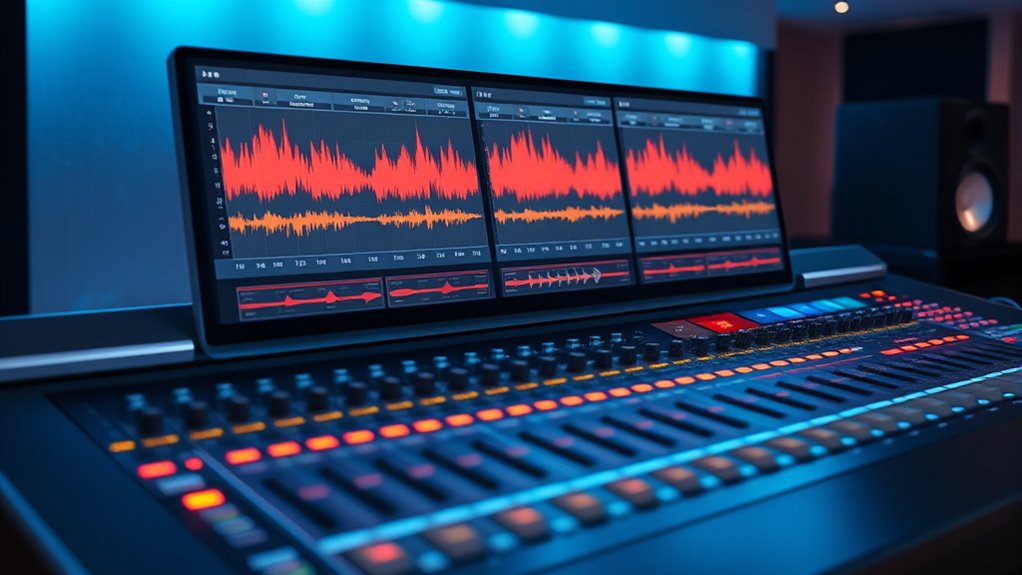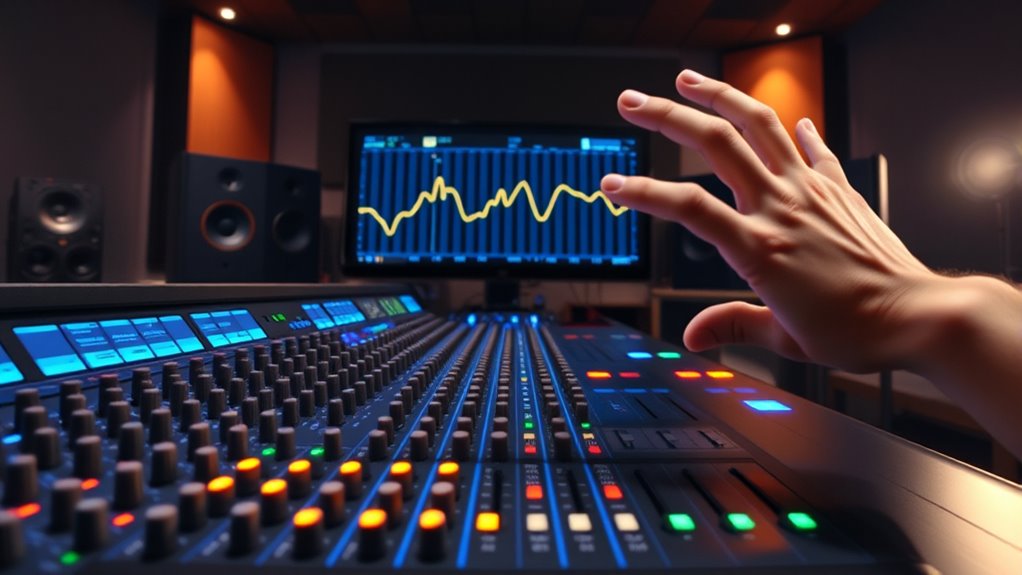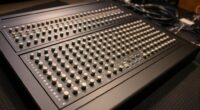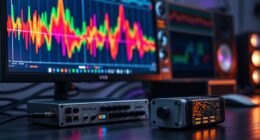To instantly polish your mix, focus on five key automation moves. Adjust volume dynamically to emphasize song energy, smoothly lowering or raising levels where needed. Use panning to create space and guide listener focus, adding movement and width. Automate reverb and delay to enhance depth, making elements feel more spacious or intimate. Shape tone by tweaking EQ parameters for clarity, and add excitement with filter sweeps and effects for build-ups. Keep exploring these techniques to elevate your mix even further.
Key Takeaways
- Use volume automation to balance song energy and emphasize key sections smoothly.
- Automate panning to create space, movement, and stereo separation for clarity.
- Apply reverb and delay automation to add depth, dimension, and dynamic spatial effects.
- Shape tone with dynamic EQ adjustments to enhance clarity and reduce muddiness.
- Incorporate filter sweeps and effects automation for excitement and musical build-ups.
Automate Volume for Dynamic Balance

To maintain peak flow and prevent bottlenecks, automating volume for dynamic balance is essential. You should set volume modulation to adapt to the song’s energy, emphasizing certain parts while dialing back others. This technique helps keep the mix engaging and prevents elements from overpowering each other. For example, bring up the vocal during the chorus or lower the rhythm section during verses to create contrast. Use automation curves to craft smooth transitions and avoid abrupt jumps that can distract the listener. It’s important to listen carefully and adjust these levels in real-time, ensuring each element sits perfectly within the overall mix. Additionally, understanding how sound effects and ambient sounds can enhance visual quality inspires confidence in making precise adjustments for optimal results. Recognizing the importance of engine tuning in automotive upgrades reminds us that meticulous calibration results in better performance and a more refined sound. Consistent volume automation helps maintain clarity, punch, and emotional impact throughout your track.
Use Panning to Create Space and Movement

Panning is a powerful tool that helps you create space and movement within your mix, making each element more distinct and engaging. By adjusting the stereo position, you guide the listener’s attention and prevent clutter. Use panning to separate instruments, such as placing guitars slightly left and right, or spreading vocals across the stereo field. Automation allows you to dynamically shift these positions, adding energy and interest. For example, pan a synth filter from left to right to add movement. Consider these techniques:
Panning creates space, movement, and clarity by dynamically positioning sounds within the stereo field.
- Automate panning to create swirling effects
- Use wide panning for spaciousness
- Narrow panning for focused elements
This approach ensures your mix feels lively and well-balanced, helping each sound find its place without overpowering others. Incorporating spatial awareness into your mixing process enhances the overall experience and clarity of your track.
Enhance Depth With Reverb and Delay Automation

Automation of reverb and delay effects adds a sense of space and dimension to your mix, making individual elements feel more immersed and lively. By automating reverb levels, you can subtly increase or decrease the sense of distance, placing instruments in different spatial planes. Delay automation, on the other hand, can create rhythmic echoes that evolve throughout the track, enhancing movement and depth. For example, you might automate a longer reverb tail during a chorus to add grandeur or reduce it during verses for clarity. Similarly, adjusting delay times or feedback levels at specific points can emphasize transitions or highlight key moments. These automated effects help your mix breathe, giving it a dynamic, three-dimensional quality that keeps the listener engaged. Incorporating techniques like sound quality enhancement can further improve the clarity and richness of your automated effects.
Shape Tone by Automating EQ Parameters

Automating EQ parameters allows you to dynamically shape the tone of individual elements throughout your mix. By adjusting frequency bands over time, you can emphasize or tame specific qualities precisely when needed. This technique helps create movement and clarity, making each instrument stand out or blend seamlessly. For example, you might brighten a vocal during a chorus or cut mud from a bass during a verse. Consider these approaches:
- Boost high frequencies during key moments to add brightness
- Sweep a midrange cut to create space for other elements
- Lower low-end frequencies to tighten the bass or reduce muddiness
- Incorporate spiritual awareness techniques to enhance your focus and decision-making during the mixing process
Using automation in this way gives you control over tonal balance, ensuring your mix stays engaging and well-defined from start to finish. Additionally, understanding your resources and tools can enhance your ability to implement these adjustments effectively. Incorporating personal growth techniques, such as mindfulness during mixing, can improve your focus and decision-making process. Moreover, exploring different audio processing techniques can help refine your mix further.
Add Excitement With Filter Sweeps and Effects

Adding excitement to your mix often involves dynamic filter sweeps and creative effects that catch the listener’s ear. You can craft movement and energy by automating filter parameters like cutoff frequency or resonance. Use sweeping effects during passages or build-ups to create anticipation. Additionally, effects such as reverb, delay, and modulation add texture and space. Automating these effects makes your mix more dynamic and engaging. Incorporating visual cues can further enhance the impact of your automation, guiding the listener’s emotional response. Being aware of support hours for your tools can help ensure you have the assistance needed when troubleshooting complex automation setups. Regularly reviewing your workflow can also help you incorporate mindful decluttering strategies, making your process more efficient and less overwhelming.
Frequently Asked Questions
How Do I Choose Which Tracks to Automate in My Mix?
When choosing which tracks to automate, focus on elements that need dynamic changes or subtle adjustments to enhance your mix. Listen for parts that benefit from volume shifts, effects, or panning to add interest and clarity. Identify vocals, drums, or instruments that stand out or sit behind others. Automate those tracks to bring energy, emphasize key moments, or create smoother progression, making your mix more engaging and polished.
What Are Common Pitfalls When Automating Effects?
When automating effects, you might fall into common pitfalls like overdoing it, making your mix feel unnatural or cluttered. You could also forget to listen critically, leading to inconsistent levels or effects that clash. Automation can sometimes cause abrupt changes if not smoothed properly. To avoid these issues, plan your automation carefully, use subtle adjustments, and always listen to how effects evolve throughout the track.
How Can Automation Improve the Emotional Impact of My Song?
You can really turn up the emotional impact of your song by using automation to shape dynamics and effects. It’s like adding a secret ingredient that keeps listeners hooked. By automating volume, panning, or reverb, you create ebb and flow, making the music feel alive and expressive. This personal touch helps convey the mood more vividly, ensuring your message hits home and resonates deeply with your audience.
What Software Features Make Automation Easier to Manage?
Automation is essential for dynamic mixes, and software features greatly simplify managing it. Look for intuitive lane views that let you easily draw, adjust, and visualize automation curves. Features like snap points, flexible curves, and easy copying make editing smoother. Additionally, automation shortcuts and clear labeling help you stay organized. These tools save you time, improve precision, and give you full control over your mix’s emotional impact.
How Do I Prevent Automation From Sounding Unnatural or Robotic?
You want your automation to sound natural, not robotic. Imagine adjusting volume gradually during a song’s chorus; if you move the fader smoothly, it blends seamlessly. To prevent harsh changes, use smaller, more frequent adjustments instead of big jumps. Employing curves or curves easing can also help create more human-like dynamics. Practice gentle, subtle movements, and your automation will sound organic and lively, just like a real performance.
Conclusion
By mastering these automation moves, you’ll turn your mix into a vibrant tapestry of sound. Think of automation as the brushstrokes that bring your track to life, adding depth, movement, and emotion. With a few strategic tweaks, your mix transforms from a static image into a dynamic masterpiece—each element dancing in harmony like stars in a constellation. Embrace these techniques, and watch your music shine brighter than ever.









